|
|
 |
|
Calanoida ( Order ) |
|
|
|
Clausocalanoidea ( Superfamily ) |
|
|
|
Aetideidae ( Family ) |
|
|
|
Chirundina ( Genus ) |
|
|
| |
Chirundina streetsii Giesbrecht, 1895 (F,M) | |
| | | | | | | Syn.: | Euchirella carinata Wolfenden, 1902 (p.366, Descr.M); 1904 (p.115, Descr.F); 1911 (p.236, Rem.); Chirudina streetsi : With, 1915 (p.141, figs.F,M) | | | | Ref.: | | | Giesbrecht, 1895 c (p.249, Descr.F, figs.F); Giesbrecht & Schmeil, 1898 (p.34, Rem. F); Esterly, 1906 a (p.59, figs.F,M); Farran, 1908 b (p.37); A. Scott, 1909 (p.43, figs.F,M, Rem.); Wolfenden, 1911 (p.241, fig.); With, 1915 (p.141, figs.juv., F,M); Lysholm & Nordgaard, 1921 (p.16); Sars, 1925 (p.77, figs.F,M); Farran, 1926 (p.254); 1929 (p.208, 234: juv.); Rose, 1929 (p.23); Wilson, 1932 a (p.48, Rem.F,M, figs.M); Rose, 1933 a (p.107, figs.F,M); Jespersen, 1940 (p.26); Lysholm & al., 1945 (p.19); Sewell, 1947 (p.95, Rem.F); Brodsky, 1950 (1967) (p.180, figs.F,M); Vervoort, 1952 h (n°49, p.3, figs.F,M); Tanaka, 1957 b (p.190, figs.F,M); Grice, 1962 (p.196, figs.F); Paiva, 1963 (p.36, figs.F); Vervoort, 1963 b (p.152, Rem.); Gaudy, 1963 (p.23); Owre & Foyo, 1967 (p.49, figs.F,M, Rem.); Tanaka, 1969 (p.262, Rem.); Tanaka & Omori, 1970 a (p.143); Bradford, 1970 a (p.353, figs.F); Park, 1978 (p.179, figs.F, Rem.); Bradford & Jillett, 1980 (p.27, figs.F,M, distribution chart); Gardner & Szabo, 1982 (p.244, figs.F,M); Vaupel Klein, 1984 a (p.51, figs.F, Table II: characters); 1986 (p.494); Markhaseva, 1996 (p.130, figs.F,M); Chihara & Murano, 1997 (p.684, Pl.28: F,M); Bradford-Grieve & al., 1999 (p.879, 919, figs.F,M); Mulyadi, 2004 (p.55, figs.F, Rem.); Vives & Shmeleva, 2007 (p.558, figs.F,M, Rem.) |  issued from : O. Tanaka in Publ. Seto mar. Biol., Lab., 1957, 6 (2). [Fig.53, p.191]. Female (from Sagami): a, habitus (dorsal aspect); b, head (lateral aspect); c, last thoracic segment and urosome (lateral aspect, right side); d, rostrum (anterior aspect); e, P1; f, P2. Male (from Suruga): g, head (lateral aspect, left side); h, Mx2; i, P5. Nota Female: - Cephalothorax about 3.73 times the abdomen length. - Forehead with a median crest. - Rostrum strong, one-pointed. - Lateral corners of last thoracic segment produced triangularly with each a pointed knob at the apex. - Abdomen 4-segmented; segments and caudal rami in proportional lengths 48 : 19 : 12 : 5 : 16 = 100. - Genital segment swollen toward the distal end; ventrally surface of segment with a moderate protuberance just above genital opening. - Posterior margin of 3rd abdominal segment fringed with fine teeth. - Caudal rami about as long as wide.. - A1 23-segmented, exceeds slightly distal end of caudal rami; segment 8-9 and 24-25 fused. - A2 exopod 1.6 times as long as endopod. - P1 exopod incompletely 3-segmented; the articular membrane between 1st and 2nd segments obseved distinctly on the anterior surface. P2: 1st endopodal segment with an accessory tooth. Nota Male: - Cephalothorax about 2.7 times the abdomen length (3.50 : 1/31). - Forehead with a median crest. - Lateral corners of last thoracic segment rounded. - Abdomen 5-segme,ted; segments and caudal rami in proportional lengths 23 : 32 : 27 : 20 : 7 : 11 = 100. - 2nd to 4th abdominal segments fringed with fine teeth on posterior margin. - A1 extends to the middle of the 2nd abdominal segment; the left one is 21-segmented, the right 20-segmented. - Maxillae and Mxp are reduced. - P1: exopod 3-segmented, endopod 1-segmented. - P2: terminal exopodal spine with 33 teeth. - P3 with terminal exopodal spine of 24 teeth. P4: with terminal exopodal spine of 33 teeth.
P5 as figured by Sars.
|
 issued from : T. Park in Antarctic Res. Ser. Washington, 1978, 27. [p.180, Fig.52]. Female: A, habitus (dorsal view); B, idem (left side); C, forehead (dorsal); D, idem (left lateral side); E, posterior part of metasome and urosome (lateral); F, idem (dorsal view); G, genital segment (ventral); H, A2.
|
 issued from : T. Park in Antarctic Res. Ser. Washington, 1978, 27. [p.181, Fig.53]. Female: A, Md; B, Mx1; C, Mx2; D, Mxp; E, P1; F, P2; G, P3; H, P4; P1-4: legs (anterior).
|
 issued from : E.L. Markhaseva in Proc. Zool. Inst. RAN, St. Petersburg, 1996, 268. [p.133, Fig.101]. Female (from NW Pacific). Ce: forehead (dorsal and lateral, respectively). Nota: Posterior corners of last thoracic segment slightly prolonged , of ten ending in small knob or teeth, their shape may vary. A1 24-segmented, longer than cephalothorax, often reaching the distal end of caudal rami. A2 with exopod 1.5 times longer than endopod.P1 with indistinct separation between exopodal segments 1 and 2.
|
 issued from : J.M. Bradford & J.B. Jillett in Mem. N.Z. Oceanogr. Inst., 86, 1980. [p.28, Fig.15]. Female: A, habitus (dorsal); B, idem (lateral left side). Male: C, habitus (dorsal); D, forehead (lateral); E, P5.
|
 issued from : J.M. Bradford in N.Z. Jl Mar. Freshw. Res., 1970, 4 (4). [p.353, Figs 13-14]. Female (off Kaikoura, New Zealand): 13, P1; 14, forehead (lateralright side) Scale bars represent 0.1 mm.
|
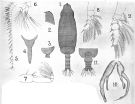 issued from : A. Scott in Siboga-Expedition, 1909, XIX a. [Plate XII, Figs.1-11]. Male (from Indonesia-Malaysia): 1, habitus (dorsal); 2, forehead (lateral); 3, last thoracic and genital segments (left side); 4, rostrum; 5, A1; 6, A2; 7, Mxp; 8, P1; 9, P2; 10, P5. Female: 11, last thoracic segment and urosome (dorsal).
|
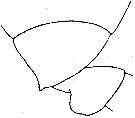 issued from : R.N. Wolfenden in Die Marinen Copepoden der Deutschen Südpolar-Expedition 1901-1903, 1911. [p.241, Fig.26]. Female: posterior part cephalothorax and genital segment (lateral, left side).
|
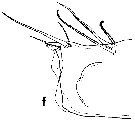 issued from : J.C. von Vaupel Klein in Crustaceana, Supplt 9, Studies on Copepoda, III, 1984. [p.75, Fig.13, f]. Female: f, a rounded lateral tubercle present on basipodite 1 of Mxp (distal part of left appendage, lateral aspect); Compare with the same appendage in Euchirella curticauda, Fig.13, e.
|
 issued from : J.C. von Vaupel Klein in Crustaceana, Supplt 9, Studies on Copepoda, III, 1984. [p.59, Fig.12, f1-f3]. Female: fi to f3, symmetrical tubercles on the caudo-lateral corners of thoracic segments 4+5 (lateral view of left tubercle, dorsal aspect and dorsal view of right tibercle, respectively).
|
 issued from : J.C. von Vaupel Klein in Crustaceana, Supplt 9, Studies on Copepoda, III, 1984. [p.84, Fig.18, b]. Female: b, number and structure of spines among the lateral margin of exopodal segments 1, 2 and 3 of P1 (right appendage, anterior aspect) (note: three subequal spines of moderate length, all bipectinate).
|
 issued from : C.O. Esterly in Univ. Calif. Publs Zool., 1906, 3 (5). [Pl.9, Fig.2]. Female (from San Diego, California): 2, forehead (lateral).
|
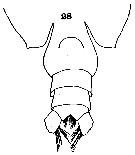 issued from : C.O. Esterly in Univ. Calif. Publs Zool., 1906, 3 (5). [Pl.10, Fig.28]. Female: 28, last thoracic segment and urosome (ventral).
|
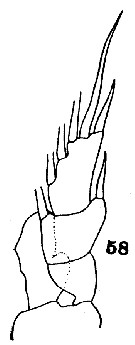 issued from : C.O. Esterly in Univ. Calif. Publs Zool., 1906, 3 (5). [Pl.12, Fig.58]. Male: 58, P1 (bristles not shown on endopod).
|
 issued from : C.O. Esterly in Univ. Calif. Publs Zool., 1906, 3 (5). [Pl.14, Figs.86, 87]. Male: 86, right P5; 87, left P5.
|
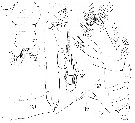 issued from : W. Giesbrecht in Bull. Mus. comp. Zool. Harv., 25 (12). [Taf. I, Figs.5-10]. Female (from 35°N, 125°W): 5, urosome (ventral); 6, Mxp; 7, P1 exopod; 8, forehead (lateral); 9, Mx1; 10, urosome (lateral, right side).
|
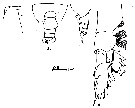 issued from : G.D. Grice in Fish. Bull. Fish and Wildl. Ser., 1962, 61. [p.197, Pl.11, Figs.1-4]. Female (from 00°03'S, 157°00'E): 1, forehead (lateral); 2, posterior part of thorax and urosome (dorsal); 3, same (lateral, left side). Nota: Pronounced crest on forehead. Presence of 2 spines on the 1st exopodal segment of P1.
|
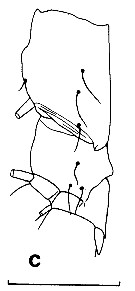 issued from : J.C. von Vaupel Klein in Crustaceana, Supplt 9, Studies on Copepoda, III, 1984. [p.82, Fig.17, c]. Female: c, arrangement of hair-sensilla on the posterior face of the proximal segments of right P4. Nota: 3 sensilla on basipodal segment 1 and 3 on Ba2. Scale bar 0.4 mm (b, g); 0.2 (i).
|
 issued from : J.C. von Vaupel Klein in Crustaceana, Supplt 9, Studies on Copepoda, III, 1984. [p.80, Fig.16, a, b]. Female: a, number, shape, and size denticles along the lateral edge od the terminal seta on exopdal segment 3 of P1; b, detail of the same seta. Scale bar: 0.4 mm (a); 0.067 mm (b).
|
 issued from : J.C. von Vaupel Klein in Crustaceana, Supplt 9, Studies on Copepoda, III, 1984. [p.65, Fig.6 a]. Chirundina streetsii: a, Setal armature of endopodte 2+3 of A2. Conditions are expressed are expressed in formulae as follows: number of setae in regular row on proximal lobe / relative development of seta in position no. 9 on this lobe / number of setae in approximately linear row on terminal lobe / relative development of appendicular seta no.7 and its supporting pedestral (absent, vestigial, moderate or well developed: see Table I, p.87 and Table II, p.93). p and t = proximal and terminal lobes (details of right appendage shown in medial aspect. Scale bar = 0.133 mm. Nota: Condition 8/3/6/3 in a non- Euchirella euchirellinid.
|
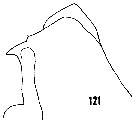 issued from : H.B. Owre & M. Foyo in Fauna Caribaea, 1, Crustacea, 1: Copepoda. Copepods of the Florida Current. [p.26, Fig.121]. Female: 121, forehead (lateral).
|
 issued from : H.B. Owre & M. Foyo in Fauna Caribaea, 1, Crustacea, 1: Copepoda. Copepods of the Florida Current. [p.49, Fig.282]. Female: 282, habitus (dorsal).
|
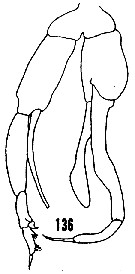 issued from : H.B. Owre & M. Foyo in Fauna Caribaea, 1, Crustacea, 1: Copepoda. Copepods of the Florida Current. [p.29, Fig.136]. Male: 136, P5.
|
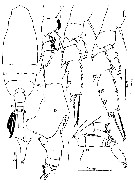 issued from : Mulyadi in Published by Res. Center Biol., Indonesia Inst. Sci. Bogor, 2004. [p.55, Fig.30]. Female (from Flores Sea): a, habitus (dorsal); b, forehead (lateral); c, posterolateral end of last thoracic segment and urosome (lateral left side); d, rostrum (anterior view); e, A2; f-h, P1 to P3, respectively.
|
 Chirundina streetsii Chirundina streetsii female: 1 - Crest on cephalon present. 2 - Exopodal segment 1 of P1 with external spine. Cephalothorax about 3-4 times longer than urosome.
|
 Chirundina streetsii Chirundina streetsii male: 1 - Exopodal segment 1 of P1 with external spine. Cephalothorax 2.7-3.8 times longer than urosome.
|
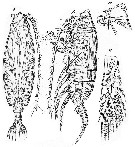 Issued from : G.O. Sars in Résult. Camp. Scient. Prince Albert I, 69, pls.1-127 (1924). [Pl.XXII, figs.8-11]. Female: 8, habitus (dorsal); 9, idem (lateral left side); 10, forehead (lateral); 11, P1.
|
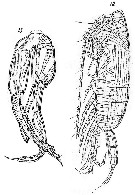 Issued from : G.O. Sars in Résult. Camp. Scient. Prince Albert I, 69, pls.1-127 (1924). [Pl.XXII, figs.12-13]. Male: 12, habitus (lateral); 13, P5.
|
 issued from : E.L. Markhaseva in Proc. Zool. Inst. RAN, St. Petersburg, 1996, 268. [p.134, Fig.102]. Male: P5, Ce (from Tanaka, 1957); P5 (a) (from With, 1915). Nota: P5 similar to that in Undeuchaeta plumosa. Both endopodal segment 1 1-segmented. Right endopod slightly shorter than right exopod. Left endopod slightly slightly longer than rifgt endopodal segment 1. Esopodal segment 1 of right with 2 big and 1 small teeth proximally on the external edge. Right exopodal segment 2 with groove and terminal spine, the latter is equalling 2/3 of segment in length. Exopod of left leg 3-segmented, exopoddal segment 2 comparatively short with short spine and with obtuse tooth and rounded projection.
|
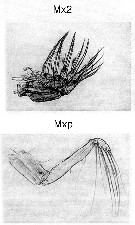 Issued from : M. Sano, K. Maki, Y. Nishibe, T. Nagata & S. Nishida in Progr. Oceanogr., 2013, 110. [p.19, Figs. 8 a, 9, a]. Second maxilla (Mx2) and maxilliped (Mxp) of Chirundina streetsii from Sagami Bay (Japan) in April 2009. Scale bars: 200 µm. Compare appendage structure and setal armement with Euchirella rostrata, Undeuchaeta major, Pleuromamma xiphia, Scaphocalanus echinatus, Scottocalanus helenae, Scottocalanus securifrons, Spinocalanus magnus and calanus sinicus for interpreted particles catching.
|
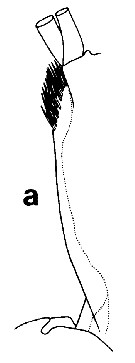 issued from : J.C. von Vaupel Klein in Crustaceana, Supplt 9, Studies on Copepoda, III, 1984. [p.66, Fig.7, a]. Chirundina streetsii a, A2 arrangements of spinules and hairs on the posterior edge of endopodite 2+3 (right appendage of medial view ) > 30 spinules in distal patch.
|
 issued from : J.C. von Vaupel Klein in Crustaceana, Supplt 9, Studies on Copepoda, III, 1984. [p.66, Fig.7, m]. Chirundina streetsii: Structural feature of exopodite 1 and exopodite 2 of A2 (lateral aspects of left appendages and medial views of right antennal parts; compare with Fig.7n which represents left A2 medial face drawn from a lateral view). m, medial.
|
 Issued from : J.C. von Vaupel Klein in Crustaceana, Supplt 9, Studies on Copepoda, III, 1984. [p.72, Fig.11, f]. Chirundina streetsii. Structure of Mx1, terminal configuration of setae plus the 'blunt tooth (= tubular pore) on the endite of basis (Ba2) (plumosity and/or spinules on setae, as well as hairs on lobe, omitted, right appendage in anterior view). Showing the usual Euchirella complement of, from anterior to posterior: short proximal seta (p), long central seta (c), blunt tooth (dotted outline) and shortest, distal seta (d). Contrary to E. curticauda (see Fig.11, a), a full euchirellinid complement, arranged as in Euchirella but with an additional 4th seta (the shortest of the four) inserting even more to the posterior side than seta (d) in Chirundina streetsii.
|
 Issued from : J.C. von Vaupel Klein in Crustaceana, (Supplement) 9, 1984. [p.93, Table II ]. Chirundina streetsii Female: Datamatrix stating observed states of characters from Table I (p.87-90) presently examined; nos. refer to the input nos. used in Table I (see to the family Aetideidae).
|
 Issued from : J.C. von Vaupel Klein in Crustaceana, (Supplement) 9, 1984. [p.94, Table II (cont' d) ]. Chirundina stretsii Female: Datamatrix stating observed states of characters from Table I (p.87-90) presently examined; nos. refer to the input nos. used in Table I (see to the family Aetideidae).
|
 Issued from : J.C. von Vaupel Klein in Crustaceana, (Supplement) 9, 1984. [p.95, Table II (cont' d) ]. Chirundina streetsii Female: Datamatrix stating observed states of characters from Table I (p.87-90) presently examined; nos. refer to the input nos. used in Table I (see to the family Aetideidae).
| | | | | Compl. Ref.: | | | Cleve, 1904 a (p.187); Pearson, 1906 (p.16, Rem.); Sewell, 1948 (p.329, 500, 519, 530, 531, 539, 545); C.B. Wilson, 1950 (p.189); Grice, 1963 a (p.495); Gaudy, 1963 (p.23, Rem.); De Decker & Mombeck, 1964 (p.12); Grice & Hulsemann, 1965 (p.223); 1967 (p.14); Furuhashi, 1966 a (p.295, vertical distribution in Kuroshio region, Table 9, 10); Fleminger, 1967 a (tabl.1); Grice & Hulsemann, 1968 (tab.2); De Decker, 1968 (p.45); Vinogradov, 1968 (1970) (p.277); Morris, 1970 (p.2300); Park, 1970 (p.475); Lee & al., 1971 (p.1151); Timonin, 1971 (p.281, trophic group); Roe, 1972 (p.277, tabl.1, tabl.2); 1972 a (p.341); Harding, 1974 (p.141, tab. 3, gut contents); Vives & al., 1975 (p.41, 42, tab.II, III, XII); Tranter, 1977 (p.598); Deevey & Brooks, 1977 (p.256, tab.2: as streetsi, Station "S"); Carter, 1977 (1978) (p.35); Vives, 1982 (p.291); Gaudy & Boucker, 1983 (p.37, Table 1, Rem.: metabolism); Brenning, 1983 (p.5, Rem.); Cummings, 1984 (p.163, Table 2); Roe, 1984 (p.357); Tremblay & Anderson, 1984 (p.3, Rem.); Guangshan & Honglin, 1984 (p.118, tab.); Brenning, 1985 a (p.28, Table 2); Kinzer & Schulz, 1985 (tab.4); Madhupratap & Haridas, 1986 (p.105, tab.1); Lozano Soldevilla & al., 1988 (p.58); Madhupratap & Haridas, 1990 (p.305, fig.5: vertical distribution night/day; fig.7: cluster); Heinrich, 1990 (p.16); Shih & Young, 1995 (p.66); Suarez-Morales & Gasca, 1998 a (p107); Lapernat, 2000 (tabl. 3, 4); Razouls & al., 2000 (p.343, Appendix); d'Elbée, 2001(tabl. 1); Holmes, 2001 (p.47); Hsiao & al., 2004 (p.325, tab.1); Pusch & al., 2004 (251, tab.3); Ikeda & al., 2006 (p.1791, Table 2); Dur & al., 2007 (p.197, Table IV); Gaard & al., 2008 (p.59, Table 1, N Mid-Atlantic Ridge); Galbraith, 2009 (pers. comm.); Park & Ferrari, 2009 (p.143, Table 5, Appendix 1, biogeography); Williamson & McGowan, 2010 (p.273, Table 3, Pacific central gyres: N and S); Medellin-Mora & Navas S., 2010 (p.265, Tab. 2); Andersen N.G. & al., 2011 (p.71, Fig.3: abundance); Hsiao S.H. & al., 2011 (p.475, Appendix I); Teuber & al., 2013 (p.1, Table 1, 2, abundance vs oxygen minimum zone, respiration rate); in CalCOFI regional list (MDO, Nov. 2013; M. Ohman, comm. pers.); Sano & al., 2013 (p.11, Table 2, 4, 5, 7, A1, figs.5, 8, 9, feeding habits, gut contents, vertical distribution); Bonecker & a., 2014 (p.445, Table II: frequency, horizontal & vertical distributions); Bode & al., 2015 (p.268, Table 1, chemical components, trophic level, geographic zone); El Arraj & al., 2017 (p.272, table 2); Bode & al., 2018 (p.840, Table 1, respiration & ingestion rates, depth) | | | | NZ: | 20 | | |
|
Distribution map of Chirundina streetsii by geographical zones
|
| | | | | | | | | | | | | | |  Issued from : M. Sano, K. Maki, Y. Nishibe, T. Nagata & S. Nishida in Progr. Oceanogr., 2013, 110. [p.20, Fig.10]. Issued from : M. Sano, K. Maki, Y. Nishibe, T. Nagata & S. Nishida in Progr. Oceanogr., 2013, 110. [p.20, Fig.10].
Vertical distribution of eight copepod species across 0-1000 m in Sagami bay in 21-27 April 2009.
White and black boxes denote daytime and nighttime distributions. Scaphocalanus echinatus/em> is taken from Kuriyama & Nishida (2006).
Plankton and water samples collected from a fixed station (35°00'N, 139°20'E) using MTD horizontal closing nets (0.33 mm mesh aperture) at 15 depths (0, 50, 95, 100, 150, 195, 200, 295, 300, 395, 400, 500, 600, 800, 1000 m) during both day and night.
Atomic C:N ratio (mean ±SD) = 5.1 ±0.5, n = 5. |
 Issued from : M. Madhupratap & P. Haridas in J. Plankton Res., 12 (2). [p.312, Fig.5]. Issued from : M. Madhupratap & P. Haridas in J. Plankton Res., 12 (2). [p.312, Fig.5].
Vertical distribution of calanoid copepod (mean +1 SE), abundance No/100 m3. 41- Chirundina streetsi.
Night: shaded, day: unshaded.
Samples collected from 6 stations located off Cochin (India), SE Arabian Sea, November 1983, with a Multiple Closing Plankton Net (mesh aperture 300 µm), in vertical hauls at 4 depth intervalls (0-200, 200-400, 400-600, 600-1000 m). |
 Issued from : M. Bode, R. Koppelmann, L. Teuber, W. Hagen & H. Auel inGlobal Biogeochemical Cycles, 2018, 32. [p.844, Table 1). Issued from : M. Bode, R. Koppelmann, L. Teuber, W. Hagen & H. Auel inGlobal Biogeochemical Cycles, 2018, 32. [p.844, Table 1).
Cf. explanations of these measures in Calanoides natalis from the same authors. |
| | | | Loc: | | | sub-Antarct. (Indian, SE Pacif.), South Africa (E & W), off E Tristan da Cunha, Angola, Congo, Atlant. (central equatorial), G. of Guinea, off Cape Verde Is., off Mauritania-NW Cape Verde Is., off Morocco-Mauritania, Great Meteor Seamount, Azores, Canary Is., off Madeira, off W Cap Finisterre, Ibero-moroccan Bay, Bay of Biscay, S & central Brazil, off Amazon, Caribbean Sea, Caribbean Colombia, G. of Mexico, Florida, Sargasso Sea, off Bermuda: Station "S" (32°10'N, 64°30'W), off SE Cape Cod, off Woods Hole, off S Nova Scotia, Flemish Cape, S Iceland, W Ireland, Faroe Is., North Sea, Arabian Sea, Maldive Is., Natal, Indian, W Australia, Indonesia-Malaysia, Flores Sea, China Seas (East China Sea, South China Sea), Taiwan (SW, E), Japan, Sagami Bay, Pacif. (W equatorial), Vancouver Is., New Zealand, Pacif. (equatorial, central subtropical N), Pacific (central gyres: N and S), off Galapagos, off Peru, Hawaii, California, Pacif. (SE tropical) off Juan Fernandez Is..
Type locality: 35°N, 125°E. | | | | N: | 95 (Atlant.: 52; Indien: 12, Indo-Malaysia: 2; Pacif. W: 18; Pacif (central): 2; Pacif. E: 5) | | | | Lg.: | | | (1) F: 5,1; M: 4,5; (5) F: 5,3-4,8; M: 4,1; (7) F: 5,22; M: 3,8; (11) F: 5,35; (14) F: 5,55-4,65; M: 4,8-4,05; (17) F: 5; M: 4,3; (20) F: 5,83; (37) F: 5,55-4,15; M: 5,2-3,8; (38) F: 5,2; M: 4,2; (45) F: 5,3-5; M: 4,3-4; (47) F: 5,3; (56) F: 5,01; M: 4,81; (73) F: 5,14-4,9; (101) F: 4,94; (105) F: 5,3-4,45; M: 4,5; (112) F: 5,5-4,7; M: 4,7-4,3; (199) F: 5,44-4,56; M: 4,86-3,88; (201) F: 6-4,9; M: 5-3,4; (229) F: 5; (231) F: 5,7; 5,5; (240) M: 3,71; (244) F: 5,5; (313) F: 5,7; 5,5; (866) F: 3,6-6; M: 3,8-5,2; (1109) F: 4,9-5,17; (1122) F: 4,81; (1257) F: 4,6-5,2; {F: 3,60-6,00; M: 3,40-5,20} | | | | Rem.: | epi- to hadopelagic. Sargasso Sea: 500-1000 m (Deevey & Brooks, 1977, station "S"); In vertical tow 4000-3000 m (Harding, 1974).
Sampling depth (sub-Antarct.) : 0-1000 m. 582-820 m at Station T-1 (E Tori Is., E Japan).
Characteristics female according to Sewell (1947, p.95): Proportional lengths of cephalothorax and abdomen as 76 to 24. The proportional lengths of the various segments of the body (cephalon to caudal rami) as 526:108:87:57:90:46:34:18:34=1000. Head and 1 st pediger segment fused, a trace of segmentation can be seen in the mid-dorsal line, 4th and 5th thoracic segments fused. The 4th urosomal segment fringed along the posterior margin dorsally with a double row of needle-like spinules. Anal segment with a tuft of hairs on its ventral aspect. A1 23-segmented (segments 24-25 with incomplete fusion. In A2 the proportional lengths of the exopod and endopod as 42 to 23; the proximal two segments of the exopod bear setae that arise from papillae, one on the proximal segment and 3 on the 2nd segment.
Timonin (1971, p.282) considers the trophic interrelations in the equatorial and tropical Indian Ocean, and divides the plankters into 6 trophic groups from the litterature and the results of studies of mouth-parts structure and intestine content. This species is omnivorous.
P5 male similar to that in Undeuchaeta plumosa. After Sano & al. (2013, p.21, 22) this species is considered omnivore/detritivores based on previous studies, but also marine snow relatively non-selectively. No specimens contained fragments of oncaeid copepods in their guts. The gut contents analyses indicated the ingestion of more versatile foods than the other species studied (p.18: Table 4).
R. Stephen: Data sheets of NIO, Kochi, India (on line). | | | Last update : 19/06/2023 | |
|
|
 Any use of this site for a publication will be mentioned with the following reference : Any use of this site for a publication will be mentioned with the following reference :
Razouls C., Desreumaux N., Kouwenberg J. and de Bovée F., 2005-2025. - Biodiversity of Marine Planktonic Copepods (morphology, geographical distribution and biological data). Sorbonne University, CNRS. Available at http://copepodes.obs-banyuls.fr/en [Accessed January 05, 2026] © copyright 2005-2025 Sorbonne University, CNRS
|
|
 |
 |




































